When it comes to IoT connectivity options from a hardware perspective, there are numerous factors to consider in order to ensure optimal performance and functionality.
The choices range from Wi-Fi and Bluetooth modules to cellular, Lora, satellite, RFID, Thread, Sigfox, and Nb-IoT modules. Each option has its own set of advantages and limitations, making the selection process a complex task.
The key lies in understanding the specific needs and requirements of the IoT device, such as scalability, remote management capability, data transmission needs, power constraints, and cost considerations. By carefully evaluating these factors, one can make an informed decision that aligns with the goals of the IoT initiative.
But which connectivity option is the most suitable? That answer awaits as we delve into the intricacies of each hardware perspective.
Key Takeaways
- Wi-Fi modules and Bluetooth modules are crucial for IoT connectivity, offering low power consumption and efficient data transfer capabilities.
- Cellular modules and LoRa modules provide extensive coverage and high bandwidth for global and remote IoT applications.
- Compatibility with device size constraints, power requirements, and data transmission needs is important when selecting an IoT connectivity solution.
- Satellite modules, Zigbee modules, and other specialized modules offer robust connectivity options for specific use cases, with features such as mesh networking, reliability in challenging conditions, and low power consumption.
Wi-Fi Module
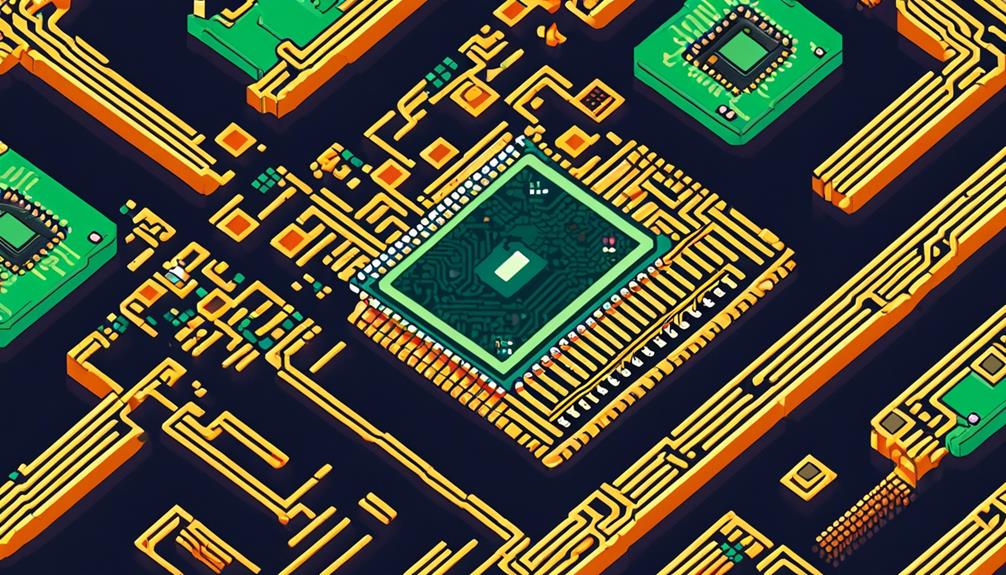
The Wi-Fi module is a crucial component that enables IoT devices to connect seamlessly to local wireless networks. These modules provide a convenient way to enable Wi-Fi connectivity for IoT devices, allowing them to transmit and receive data over the internet. Wi-Fi modules come in various form factors and support different standards, such as 802.11b/g/n/ac, ensuring compatibility with a wide range of devices and networks.
One of the key advantages of using Wi-Fi modules for IoT connectivity is their low power consumption. This is particularly important for battery-powered IoT devices, as it allows them to operate for extended periods without frequent battery replacements or recharging. Additionally, Wi-Fi modules often include integrated antennas, which can improve wireless performance and range, ensuring reliable connectivity for IoT applications.
Another benefit of using Wi-Fi modules is their ease of integration into IoT devices. These modules can be easily incorporated into the design of IoT devices, allowing for efficient and seamless connectivity. Furthermore, Wi-Fi modules offer robust IoT connectivity management capabilities, enabling secure and reliable communication between IoT devices and the cloud or other connected devices.
The Wi-Fi module plays a vital role in enabling IoT applications across various industries. It enables devices to connect to the internet, facilitating data transmission and communication. This connectivity is crucial for IoT applications, as it allows for real-time monitoring, remote control, and data analysis. Whether it is in industrial automation, smart homes, healthcare, or transportation, the Wi-Fi module ensures that IoT devices can connect and communicate effectively, enabling the full potential of IoT technology.
Bluetooth Module
Bluetooth Modules are known for their compatibility with a wide range of devices, making them a versatile choice for IoT connectivity. They offer a short-range wireless connection, typically up to 100 meters, which is suitable for applications that require proximity between devices.
Additionally, Bluetooth Modules provide efficient data transfer capabilities, allowing for the transmission of various types of data, from small intermittent packets to larger data volumes in real-time.
Compatibility With Devices
Compatibility with devices is a critical aspect to consider when selecting an IoT connectivity solution, such as a Bluetooth module. The chosen Bluetooth module should seamlessly integrate with the size constraints and design of the IoT device. It is essential to ensure compatibility with the specific power requirements of the IoT device.
Additionally, compatibility with other devices using Bluetooth connectivity should be considered for seamless communication and interoperability. The Bluetooth module's compatibility with the data transmission needs and throughput of the IoT device is important for efficient communication.
Furthermore, when evaluating compatibility, it is also necessary to compare Bluetooth with other IoT connectivity options, such as cellular connectivity and low power wide area network (LPWAN), to determine the most suitable solution for a specific hardware perspective.
Range and Data Transfer
For optimal efficiency in short-range wireless communication, the range and data transfer capabilities of Bluetooth modules play a crucial role. Here are some key facts about Bluetooth modules and their range and data transfer capabilities:
- The range of a Bluetooth module typically varies from 1 to 100 meters, depending on the class of the module and environmental factors.
- Bluetooth modules can transfer data at varying rates, with the latest Bluetooth 5 modules capable of achieving speeds of up to 2 Mbps.
- Factors such as interference, obstacles, and signal strength affect the effective range of Bluetooth data transfer.
- Bluetooth Low Energy (BLE) modules are designed for low power consumption, making them suitable for battery-operated IoT devices.
Bluetooth modules are commonly used for short-range wireless communication in IoT applications such as smart homes, wearables, and industrial monitoring systems. These modules provide reliable connectivity options for IoT devices, complementing cellular technologies for a complete IoT solution.
Cellular Module
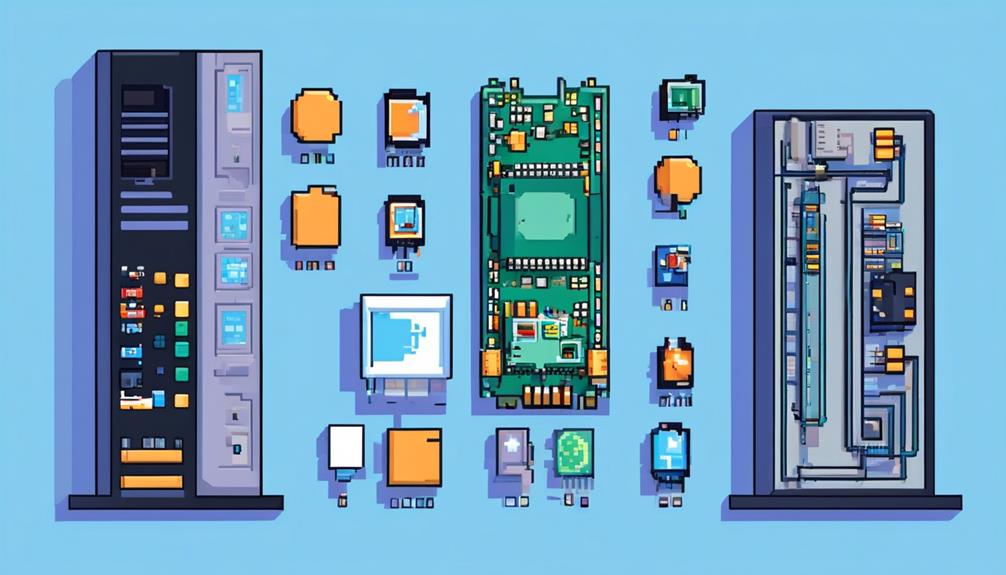
Cellular modules serve as essential components for IoT devices, facilitating their connection to cellular networks and enabling efficient data transmission. These modules come in various form factors to meet different device size constraints, making them versatile for a wide range of IoT applications.
One of the key advantages of cellular modules is their extensive global coverage. They can operate in multiple frequency bands, ensuring connectivity even in remote areas. This makes them suitable for IoT deployments that require connectivity across vast geographical regions.
In addition to global coverage, cellular modules offer high bandwidth, allowing for fast and reliable data transfer. This is particularly crucial for IoT applications that involve large amounts of data, such as video surveillance or asset tracking. Furthermore, these modules are designed with low power consumption in mind, ensuring optimal energy efficiency for IoT devices.
Another important feature of cellular modules is their ability to operate in challenging physical environments or use cases requiring mobility. They are built to withstand harsh conditions, making them suitable for applications in industries like agriculture, transportation, and healthcare.
Security is a critical aspect of IoT connectivity, and cellular modules provide strong encryption and authentication mechanisms. This ensures that data transmitted between IoT devices and the cellular network is secure and protected from unauthorized access. This makes cellular modules ideal for applications that require high levels of security, such as healthcare monitoring or industrial automation.
Lora Module
The discussion on the LoRa module begins with an overview of LoRa technology, highlighting its long-range and low-power capabilities.
This is followed by a description of the key features of the LoRa module, such as its suitability for remote and rural IoT applications, optimized power consumption, and extensive coverage.
Lora Technology Overview
LoRa technology, also known as Long Range, provides long-range and low-power wireless connectivity for IoT devices, making it a highly efficient and cost-effective solution for IoT applications across various industries.
Here are some key facts about LoRa technology:
- LoRa modules utilize the LoRaWAN protocol, providing a wide ecosystem for developers and enabling IoT applications across various industries.
- The technology prioritizes extended battery life and long-range communication for IoT devices.
- LoRa technology is particularly suitable for outdoor and rural deployments due to its long-range capabilities.
- LoRa modules are a cost-effective connectivity option for IoT devices, especially in scenarios with low data rates and extended coverage requirements.
With its long-range capabilities, low-power consumption, and cost-effectiveness, LoRa technology offers an attractive connectivity option for IoT applications. Its ability to provide reliable and efficient communication over long distances makes it an ideal choice for a wide range of IoT use cases.
Lora Module Features
Lora modules, with their long-range connectivity and low power consumption, offer versatile features for IoT deployments. These modules are well-suited for LPWAN networks, making them suitable for IoT applications in rural or remote areas.
With their low power consumption, Lora modules enable battery-powered IoT devices to operate for extended periods, reducing the need for frequent battery replacements. Additionally, these modules support secure data transmission, ensuring the confidentiality and integrity of IoT data.
The modular design of Lora modules allows for easy integration with a wide range of IoT devices and platforms, providing flexibility within the IoT ecosystem. Moreover, Lora modules provide scalable connectivity options, making them suitable for both small-scale and large-scale IoT deployments.
Lora Connectivity Benefits
Leveraging its long-range connectivity and low power consumption, the LoRa module presents significant benefits for IoT deployments.
Extended Coverage:
LoRa modules offer long-range connectivity, making them suitable for rural areas and applications requiring low-power solutions. This enables IoT devices to connect over large distances, expanding the coverage area for data transmission.
Cost-Effective Scalability:
LoRa technology provides extensive coverage and is cost-effective for large-scale IoT deployments. It allows for the deployment of a wide range of devices without the need for additional infrastructure, reducing overall costs.
Enhanced Battery Life:
With its low power consumption, LoRa modules enable longer battery life for IoT devices. This makes them suitable for remote and battery-powered applications, eliminating the need for frequent battery replacements.
Easy Integration and Customization:
LoRa modules have a large ecosystem of developers, allowing for easy integration and customization of IoT solutions. This facilitates the development and deployment of tailored IoT applications to meet specific business requirements.
Satellite Module
Satellite modules provide a robust and scalable solution for ensuring uninterrupted global connectivity for IoT devices, even in remote and challenging environments. With satellite connectivity, IoT devices can overcome the limitations of terrestrial networks and establish reliable communication across vast geographical areas. These modules are particularly suitable for IoT deployments in rural or isolated areas where cellular connectivity is limited or unavailable.
One of the key advantages of satellite modules is their ability to offer global coverage. Unlike cellular IoT, which relies on terrestrial networks, satellite connectivity provides a truly global solution, enabling IoT devices to stay connected wherever they are deployed. This is especially beneficial for applications that require continuous monitoring and data transmission, such as environmental monitoring, asset tracking, and maritime applications.
Satellite modules are designed to be low power, ensuring efficient utilization of energy resources. This is crucial for IoT devices that are often battery-powered or have limited power sources. By optimizing power consumption, satellite modules can extend the operational lifespan of IoT devices, reducing the need for frequent maintenance or battery replacements.
In addition to being low power, satellite modules are also robust and reliable. They are built to withstand extreme weather conditions and can operate in harsh environments, making them suitable for industrial applications and outdoor deployments. The reliability of satellite connectivity ensures that IoT devices can maintain consistent communication, even in challenging conditions.
Zigbee Module

Zigbee modules are known for their low power consumption, making them an attractive option for IoT applications that require long battery life.
Additionally, Zigbee's mesh networking capability allows for extended coverage and improved reliability, making it suitable for large-scale deployments.
Furthermore, Zigbee's interoperability advantages enable seamless communication between a wide range of devices, providing flexibility and scalability for IoT implementations.
Zigbee's Low Power Consumption
The low power consumption exhibited by Zigbee modules enables extended battery life and efficient energy usage for IoT devices. This makes Zigbee a favorable choice among the various connectivity options available from a hardware perspective.
Here are four key advantages of Zigbee's low power consumption:
- Extended battery life: Zigbee's low power consumption allows IoT devices to operate for extended periods without frequent battery replacement, reducing maintenance costs and increasing device uptime.
- Suitable for battery-powered devices: The low power consumption of Zigbee modules makes them well-suited for IoT devices that operate on battery power, such as wireless sensors and smart home devices.
- Ideal for infrequent data transmission: Zigbee's low power consumption is particularly beneficial for IoT applications that require devices to transmit small data packets infrequently. This ensures efficient energy usage and prolongs battery life.
- Efficient energy usage: The low power consumption of Zigbee modules contributes to efficient energy usage in IoT deployments, reducing overall power consumption and environmental impact.
Zigbee's Mesh Networking
Zigbee's Mesh Networking, also known as the Zigbee Module, utilizes a mesh topology to enable efficient and reliable communication among IoT devices. This networking approach allows data to hop between devices, ensuring that it reaches its destination even if one node fails.
Zigbee's Mesh Networking is particularly suitable for low-power, low-bandwidth applications, making it ideal for small data transmission needs. In addition to its efficiency, Zigbee's Mesh Networking provides a reliable and secure network for IoT devices. It incorporates strong encryption and authentication features to protect the data transmitted between devices.
Furthermore, Zigbee's Mesh Networking modules are well-suited for applications that require local processing and control, reducing the need for constant external network transfer.
Zigbee's Interoperability Advantages
Utilizing its standardized communication protocol, Zigbee's Mesh Networking seamlessly enables interoperability between various devices within an IoT network. This interoperability advantage of Zigbee opens up a multitude of possibilities for IoT applications.
Here are four key advantages of Zigbee's interoperability:
- Compatibility: The Zigbee module is compatible with various devices and brands, making it easy to integrate new components into existing IoT ecosystems.
- Standardization: Zigbee's standardized communication protocol ensures that Zigbee-certified devices from different manufacturers can work together without any compatibility issues.
- Mesh Networking: Zigbee's support for mesh networking promotes robust and reliable connectivity, extending the range and coverage of IoT networks.
- Low Power Consumption: With its low-power consumption capabilities, Zigbee is an ideal choice for large-scale IoT deployments that require energy-efficient connectivity.
These advantages make Zigbee a versatile and reliable option for IoT applications, offering secure and efficient connectivity for a wide range of devices and data transmission needs.
Z-Wave Module
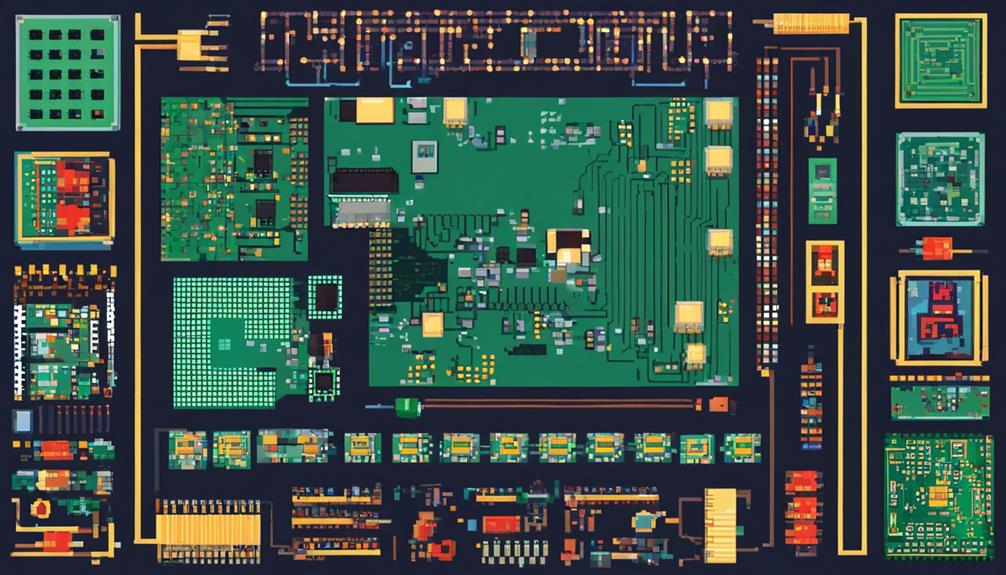
Z-Wave Module, a wireless connectivity solution for IoT devices, operates on a low-power mesh network, enabling reliable and scalable communication over longer distances. This technology has gained popularity in the IoT connectivity landscape due to its ability to provide seamless connectivity for a wide range of IoT devices.
One of the key advantages of Z-Wave Module is its low-power consumption. This makes it ideal for battery-powered IoT devices, as it helps to prolong the device's battery life. Additionally, the low-power nature of Z-Wave allows for efficient use of energy, making it a cost-effective solution for IoT deployments.
Z-Wave Module also offers a high level of scalability. It can support thousands of devices within a single network, making it suitable for both small-scale and large-scale IoT deployments. This scalability is achieved through the use of a mesh network architecture, where each device acts as a communication node, relaying data between devices to ensure reliable and robust connectivity.
To engage the audience and provide a visual representation of the capabilities of Z-Wave Module, the following table showcases a comparison between Z-Wave Module and other popular network technologies, such as Zigbee and cellular devices:
| Network Technology | Power Consumption | Scalability | Range |
|---|---|---|---|
| Z-Wave Module | Low | High | Long |
| Zigbee | Low | Medium | Medium |
| Cellular devices | High | High | Very Long |
As seen in the table, Z-Wave Module stands out for its low power consumption, high scalability, and long-range capabilities, making it a suitable choice for various IoT applications. Its ability to provide reliable and scalable communication over longer distances makes it particularly well-suited for smart home and industrial IoT deployments.
NFC Module
The next wireless connectivity solution to be discussed is the NFC Module, a short-range wireless technology that facilitates communication between devices when they are brought into close proximity. Here are some key points about NFC modules:
- NFC (Near Field Communication) module is a low-power wireless technology that enables devices to communicate over short distances.
- These modules are commonly used in contactless payment systems, access control, and data exchange between devices such as smartphones and smart posters.
- NFC modules are designed to be low-power, making them suitable for applications requiring close proximity communication.
- They are often integrated into smartphones, tablets, and other consumer electronics, allowing seamless interaction with other NFC-enabled devices.
NFC technology plays a vital role in various IoT applications, including smart home devices, wearable technology, and asset tracking systems. Its short-range capabilities make it ideal for scenarios where devices need to exchange information quickly and securely within a limited range.
From a hardware perspective, NFC modules are relatively small and can be easily integrated into various IoT devices. They provide a convenient and secure method for exchanging data, making them suitable for applications that require authentication and secure transactions.
Ethernet Module
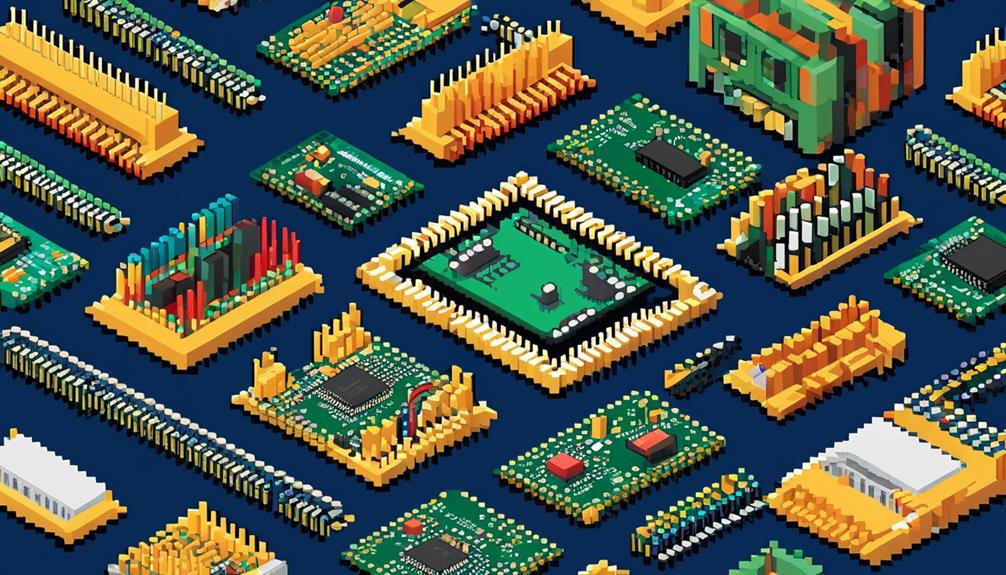
The Ethernet module provides a reliable and secure wired connectivity solution for IoT devices, allowing them to connect to a network using Ethernet cables. It is one of the IoT connectivity options from a hardware perspective. Ethernet modules offer several advantages for IoT applications.
Firstly, Ethernet modules provide a high-speed and stable connection, making them suitable for applications that require real-time data transmission. They can handle large amounts of data and offer low latency, ensuring efficient communication between connected devices.
Secondly, Ethernet modules offer reliable and secure data transmission. With built-in encryption and authentication protocols, they provide protection against unauthorized access and data breaches. This makes them ideal for industrial and commercial IoT deployments where data security is of utmost importance.
Furthermore, Ethernet modules are widely used in IoT applications that require a low power wide area network (LPWAN). LPWAN technology enables long-range communication with low power consumption, allowing IoT devices to operate for extended periods without requiring frequent battery replacements.
While Ethernet modules provide a robust and secure connectivity option, it is important to note that they require a physical Ethernet cable connection. This limitation may not be suitable for all IoT use cases, especially for devices that need to be mobile or located in remote areas without Ethernet infrastructure.
In such cases, alternative IoT connectivity options like cellular modems or wireless technologies such as Wi-Fi or Bluetooth may be more appropriate. Therefore, when considering IoT connectivity options, it is essential to evaluate the specific requirements of the application to select the most suitable solution.
RFID Module
RFID modules enable contactless identification and data transfer in IoT devices, utilizing radio frequency signals for efficient and convenient data exchange. These modules offer several advantages and options from a hardware perspective, making them a popular choice for various applications.
Here are some key features and considerations regarding RFID modules:
- Different form factors: RFID modules come in various sizes and shapes, allowing for flexibility in integration into IoT devices. This enables developers to choose the most suitable form factor based on their specific requirements.
- Communication protocols: RFID modules support different communication protocols, such as ISO/IEC 14443 for NFC applications and EPC Gen2 for UHF RFID applications. This ensures compatibility and seamless integration with a wide range of devices and systems.
- Frequency bands: RFID modules can operate in different frequency bands, including low frequency (LF), high frequency (HF), and ultra-high frequency (UHF). The choice of frequency depends on the specific use case and environment. For example, LF RFID modules are suitable for short-range applications, while UHF RFID modules offer longer range capabilities.
- Connectivity options: RFID modules can be connected to IoT devices through various interfaces, such as UART, SPI, or I2C. This allows for easy integration and communication with other components of the IoT system.
Thread Module

The incorporation of Thread Modules revolutionizes wireless communication in IoT applications by providing a robust and secure mesh network. Thread Modules are wireless communication modules specifically designed for IoT applications. They operate on the Thread networking protocol, which ensures a reliable and secure mesh network for IoT devices. With low power consumption, Thread Modules are suitable for battery-powered IoT devices, making them an ideal choice for various IoT applications.
One of the key advantages of Thread Modules is their ability to easily integrate with existing IoT ecosystems. This seamless integration allows for the creation of robust connectivity solutions for smart homes and industrial applications. Thread Modules support IPv6, enabling IoT devices to connect seamlessly to the internet and cloud services. This connectivity is crucial for IoT applications as it allows for data collection, analysis, and remote control of devices.
The robust and secure mesh network provided by Thread Modules ensures reliable and efficient communication between IoT devices. This mesh network topology allows for multiple devices to connect and communicate with one another, creating a highly interconnected network. This capability is particularly useful in applications where devices need to communicate with each other without relying on a central hub.
Sigfox Module
With the robust connectivity provided by Thread Modules, the discussion now turns to the Sigfox Module, which offers long-range and low-power IoT connectivity for devices operating in remote or challenging environments. The Sigfox module is a key player in the field of Low Power Wide Area (LPWA) connectivity options, providing an energy-efficient and cost-effective solution for IoT deployments.
Here are four key features of the Sigfox module that make it a suitable choice for IoT deployments:
- Long-range coverage: The Sigfox network has a wide coverage area, enabling devices equipped with Sigfox modules to communicate over long distances. This makes it an ideal choice for IoT devices deployed in remote or rural areas where conventional cellular networks may not provide adequate coverage.
- Low-power consumption: Sigfox modules are designed to operate on low power, allowing IoT devices to have extended battery life. This is especially beneficial for applications that require devices to be deployed in locations where power is not readily available or where frequent battery replacements are not feasible.
- Small data transmission: Sigfox modules are optimized for applications that require small amounts of data to be transmitted infrequently. This makes them suitable for IoT devices that generate low-frequency, low-bandwidth data, such as environmental sensors or asset tracking devices.
- Cost-effective solution: The Sigfox module offers a cost-effective connectivity option for IoT deployments. The low-power consumption and small data transmission requirements result in reduced network infrastructure costs and lower data subscription fees compared to other connectivity options.
Nb-Iot Module
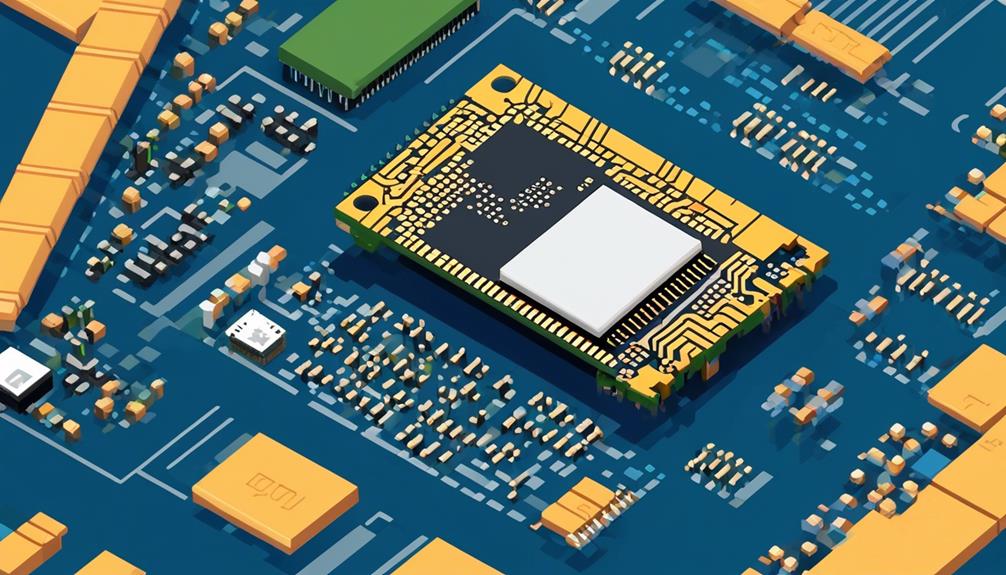
Nb-IoT modules provide reliable and cost-effective connectivity for IoT applications, making them an essential component for deployments in diverse industrial environments. These modules operate on low power and offer extended coverage for IoT devices, making them suitable for applications that require long battery life and low data transmission rates. Nb-IoT modules are known for their cost-effectiveness and ability to provide reliable connectivity in various environments.
The table below highlights some key features and benefits of Nb-IoT modules:
| Features | Benefits |
|---|---|
| Low Power Consumption | Prolongs battery life for IoT devices |
| Extended Coverage | Enables connectivity in remote and challenging physical locations |
| Cost-Effectiveness | Reduces overall deployment costs |
| Reliable Connectivity | Ensures stable data transmission for IoT applications |
Nb-IoT modules support efficient data transmission, making them ideal for IoT deployments in challenging physical locations. They are compatible with a range of IoT devices, enabling connectivity for diverse industrial applications. With their low power consumption and extended coverage, Nb-IoT modules offer a reliable and cost-effective solution for IoT connectivity.
Frequently Asked Questions
What Are the Connectivity Options in Iot System?
Wireless protocols, cellular connectivity, Ethernet options, satellite connectivity, and IoT gateway solutions are among the connectivity options available in IoT systems. These options enable devices to connect and communicate with each other and the internet.
It is crucial to carefully consider factors such as network coverage, power consumption, data transmission needs, cost, and security implications when choosing the appropriate IoT connectivity technology.
Reliable connectivity is essential for maintaining safety, profitability, and operational functioning in various industries.
What Are the Hardware Requirements for Iot?
The hardware requirements for IoT encompass various aspects such as sensor integration, power efficiency, data storage, wireless protocols, and security measures.
Sensor integration involves seamlessly incorporating sensors into IoT devices to collect relevant data.
Power efficiency is crucial to ensure longer battery life for battery-powered IoT devices.
Sufficient data storage capacity is necessary to store and process the large volumes of data generated by IoT devices.
Wireless protocols enable efficient communication between IoT devices and networks.
Security measures are essential to protect IoT devices and data from unauthorized access and cyber threats.
What Are the Perspectives of Iot?
The perspectives of IoT encompass a wide range of factors that impact its implementation and adoption.
Benefits of IoT in different industries include increased efficiency, improved decision-making, and enhanced customer experiences.
However, challenges such as interoperability, data privacy, and security need to be addressed.
Cloud computing plays a crucial role in IoT by providing scalable and reliable infrastructure for data storage and processing.
Future trends in IoT technology include the integration of artificial intelligence and machine learning to enable more intelligent and autonomous devices.
What Are the Iot Connectivity Models?
Wireless protocols, such as cellular networks, IoT gateways, and low power wide area networks, are among the various IoT connectivity models available. These options provide different capabilities and trade-offs in terms of power consumption, range, and bandwidth.
IoT connectivity standards also play a crucial role in determining the compatibility and interoperability of devices. Selecting the appropriate connectivity model is vital for ensuring seamless data exchange, automation, and innovation in IoT systems while considering factors like coverage, power consumption, data transmission, and cost implications.
